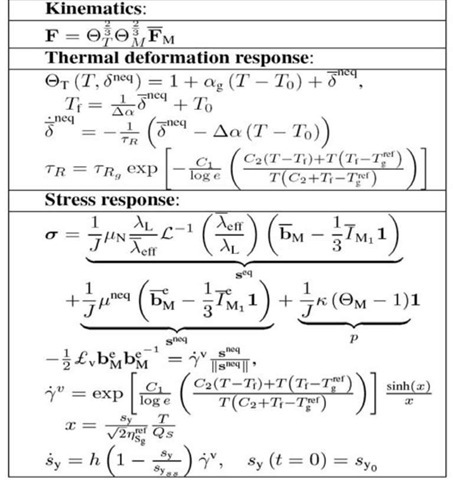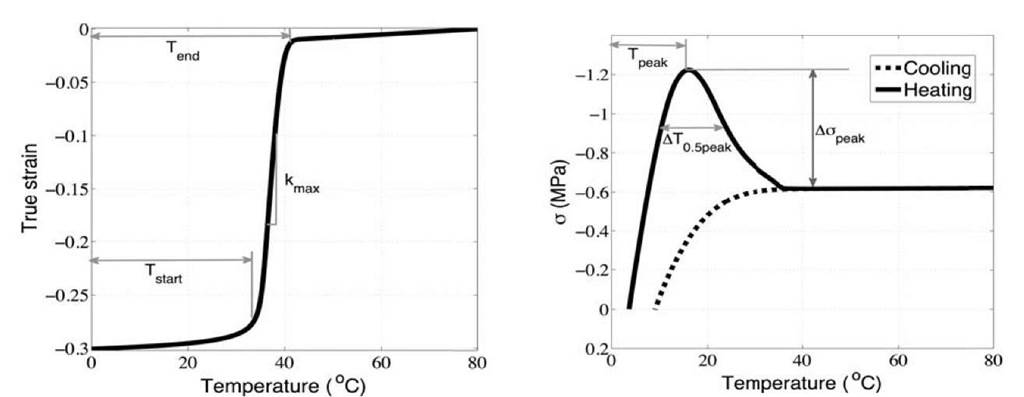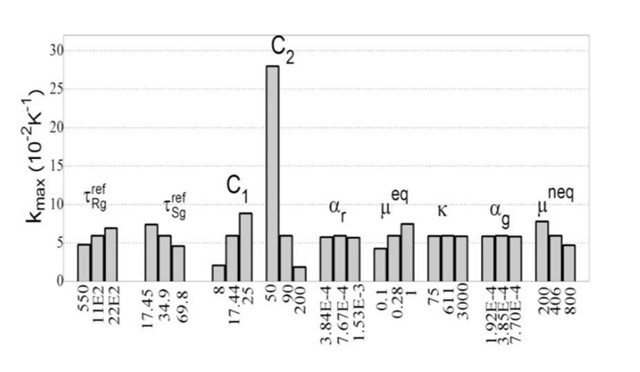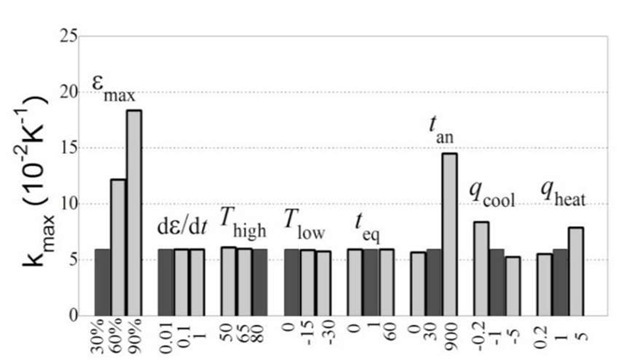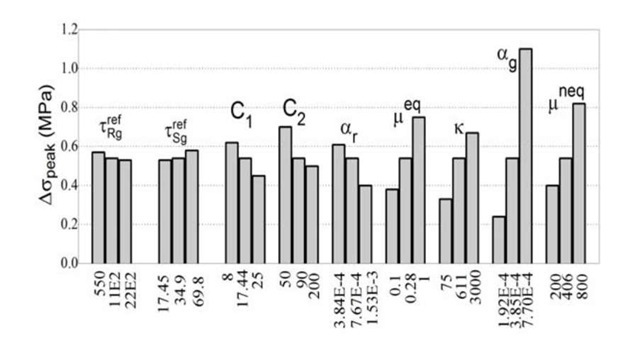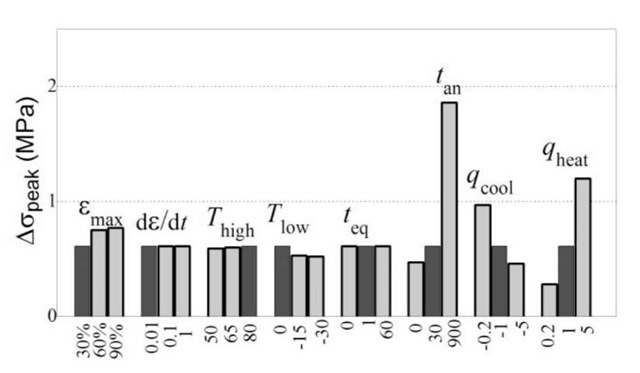Abstract
This work presented a parameter study to investigate the influence of material properties and loading conditions on the recovery performance of amorphous shape memory polymers using a recently developed thermoviscoelastic model. The model incorporated the time-dependent effects of both structural relaxation—using a nonlinear Adam-Gibbs model—and viscoelasticity. The model can predict well the unconstrained strain recovery response and stress evolution during constrained recovery process. The materials properties and the loading parameters, including the cooling rate, the annealing time, and the heating rate, were varied one by one to compare the effects on the start and end temperatures and recovery time of the unconstrained recovery response and on the stress hysteresis of the constrained recovery response. The results confirmed experimental observations that unconstrained strain recovery response was mostly influenced by viscoelasticity, while the constrained recovery response resulted from the interaction of many different mechanisms, including structural and stress relaxation, thermal expansion, the modulus of rubbery and glass state. The results also showed that the cooling and heating rates had the largest influence on both recovery responses.
Introduction
Shape memory polymer (SMP) amorphous networks offer a broad range of mechanical, chemical, and biological tailor-ability. These features make SMP materials attractive for biomedical applications, such as implants and devices for minimally invasive surgery [1,2]. An example of thermally active, amorphous SMP materials is a family of random copolymers synthesized from tert-butyl acrylate monomers and poly (ethyleneglycol) demethacrylate cross-linkers. The thermomechanical properties of the tBA-co-PEDGMA networks can be tailored by varying the weight fraction and the molecular weight of the cross-linkers [3]. Nguyen et al. [4] has developed a finite deformation thermoviscoelastic model for amorphous SMP networks that incorporates the mechanisms of structural and stress relaxation to model the dependence of the recovery response on the loading rate and cooling rate of the shape memory programming cycle and the heating rate during deployment. The model can reproduce the temperature dependence of the unconstrained recovery response and the hysteresis in the stress-temperature curve of the constrained recovery response. Based on this model, a parameter study was performed to characterize the effect of mechanical properties of SMPs and loading conditions on the unconstrained and constrained strain recovery performance.
Model Formulation and simulation process:
A detailed description of the thermoviscoelastic model was presented in Nguyen et al.[4]. Here we present only a brief description of the model.
Fig 1 Rheological representation of the constitutive model
Fig 1 shows a linear rheological model analogy of the generalized finite deformation thermoviscoelastic model. The total deformation is decomposed into an isotropic thermal part and a mechanical part, F=©TFm, where the mechanical deformation gradient is further split into elastic and viscous decompositions Fm=Fe Fv. The constitutive relations of the model for the thermal dilatation © T, the internal deformation components, and stress response are summarized in Table 1. The important innovations of the model include the incorporation of the nonlinear Adam-Gibbs [5,6,7] model for structural relaxation and the glass transition in a finite-deformation thermoviscoelastic framework and the inclusion of both viscoelastic and structural relaxation processes to model the relaxation exhibited by the materials.
Table 1: Thermoviscoelastic model.
The parameters in the model listed in Table 2 were determined by a series of thermomechanical experiments with detailed information in Nguyen et al[4]. Here the parameters were varied one to one from the baseline values as shown in the paper. The effect of the loading conditions on the recovery behavior was also investigated by varying the loading parameters in Table 3.
Table 2: Parameters of the Thennoviscoelastic Model
Table 3: Themiomechaiiical loading parameters
Results and Discussions:
Fig 2 shows the results of the unconstrained and constrained response calculated for the baseline parameters. The recovery rate was defined by the maximum slope of the unconstrained recovery curve, kmax,. The peak stress overshoot of the constrained recovery response was defined as the difference between the maximum stress of the heating and loading stages. Fig 3 shows the influence of thermoviscoelastic properties and loading conditions on the behavior of unconstrained recovery.
Fig 2 (a) The strain-temperature curve of the unconstrained recovery response and (b) the stress-temperature of the constrained recovery response calculated for the baseline material properties and loading conditions in Table 2 and 3.
The rubbery and glassy coefficients of thermal expansion Or and ag had a negligible influence on the unconstrained recovery response. A larger structural relaxation time produced a faster recovery rate. A larger structural relaxation time caused the stress relaxation time to respond more slowly to a temperature change thus shifting the onset of strain recovery to a higher temperature. A smaller stress relaxation time provided a narrower glass transition temperature range, which also resulted in a faster recovery rate. Both the rubbery and glassy modulus had a noticeable influence on the slope of the unconstrained recovery. A higher rubbery modulus and smaller glassy modulus resulted in a higher recovery rate. The WLF constants, C and C2, directly influenced the glass transition temperature range and had the most significance effect on the slope value.
The recovery rate was influenced most by the cooling, heating rate and annealing time, which indicated that structural relaxation was important to the unconstrained recovery behavior. A slower cooling rate and a longer annealing time gave the material more time to evolve to an equilibrium configuration during cooling. This results in a more initially sluggish response during reheating and led to a higher onset temperature and a faster recovery rate. In contrast, a slower heating rate allowed strain recovery to start at a lower temperature and led to a slower recovery rate.
Fig 3 Effects of the (a) thermoviscoelastic material properties and (b) loading conditions on the recovery rate of the unconstrained recovery response.
The recovery rate was influenced most by the cooling, heating rate and annealing time, which indicated that structural relaxation was important to the unconstrained recovery behavior. A slower cooling rate and a longer annealing time gave the material more time to evolve to an equilibrium configuration during cooling. This results in a more initially sluggish response during reheating and led to a higher onset temperature and a faster recovery rate. In contrast, a slower heating rate allowed strain recovery to start at a lower temperature and led to a slower recovery rate.
Fig 4 shows the influence of the thermoviscoelastic properties and loading conditions on the stress overshoot of the constrained recovery response. The peak stress overshoot is greatly influenced by glassy thermal coefficient ag and non-equilibrium modulus p,neq, which indicated that the stress overshoot was caused by the constrained thermal expansion in the heating process. A higher ag provided a larger thermal strain, while a higher p,neq produced a stiffer material. Both led to a larger stress overshoot. The WLF constants and relaxation time influenced the stress overshoot by influencing the glass transition . The annealing time, cooling rate, and heating rate had the most significance effect on the stress overshoot. A longer annealing time, smaller cooling rate, and faster heating rate all produced a stiffer material during heating process which will produce a higher overshoot.
Fig 4 Effects of the (a) thermoviscoelastic material properties and (b) loading conditions on the peak stress overshoot of the constrained recovery response.
Conclusion:
The simulation results revealed the unconstrained strain recovery response was influenced mainly by viscoelastic and structural relaxation. In contrast, the constrained recovery response resulted from the interaction of many different mechanisms, including structural and stress relaxation and thermal expansion. The result also revealed that the cooling and heating rate had the largest influence on constrained recovery responses. Currently we are working on incorporating multiple viscoelastic and structural relaxation processes to model the broad relaxation spectrum exhibited by the materials. This will improve the prediction of the unconstrained recovery rate.

